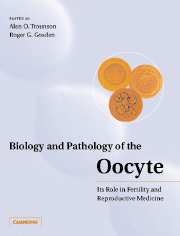Book contents
- Frontmatter
- Contents
- List of contributors
- Preface
- Part I Historical perspective
- Part II Life cycle
- Part III Developmental biology
- 6 Oocyte-specific gene expression: roles in folliculogenesis, fertilization and early development
- 7 Storage and functional recovery of molecules in oocytes
- 8 Endocrine regulation of meiosis - local and systemic hormonal influences
- 9 Checkpoint controls in mammalian oocytes
- 10 Fertilization: fate of sperm components after ICSI
- 11 Activation of the mammalian egg
- 12 Clinical applications in symmetry, asymmetry and polarity in early human development
- Part IV Pathology
- Part V Technology and clinical medicine
- Index
6 - Oocyte-specific gene expression: roles in folliculogenesis, fertilization and early development
from Part III - Developmental biology
Published online by Cambridge University Press: 05 August 2016
- Frontmatter
- Contents
- List of contributors
- Preface
- Part I Historical perspective
- Part II Life cycle
- Part III Developmental biology
- 6 Oocyte-specific gene expression: roles in folliculogenesis, fertilization and early development
- 7 Storage and functional recovery of molecules in oocytes
- 8 Endocrine regulation of meiosis - local and systemic hormonal influences
- 9 Checkpoint controls in mammalian oocytes
- 10 Fertilization: fate of sperm components after ICSI
- 11 Activation of the mammalian egg
- 12 Clinical applications in symmetry, asymmetry and polarity in early human development
- Part IV Pathology
- Part V Technology and clinical medicine
- Index
Summary
Introduction
In mammals, the XX gonad develops into an ovary that defines the female phenotype and, through its germ cells, provides genetic material for ensuing generations. Sex determination occurs during embryogenesis and the subsequent sexual dimorphism of the adult reflects sex hormones secreted from female and male gonads. Although the primacy of somatic cells in defining gender during mammalian development is well established, oocyte-specific genetic hierarchies also play essential roles in successful gonadogenesis. The observation that rodents lacking oocytes, due to genetic mutations or chemical ablation, do not form functioning ovaries indicates that interactions between germ and somatic cells are essential for normal ovarian development. During their growth, oocytes transcribe genes and translate proteins including those that form an external egg coat to which sperm bind at fertilization and that is subsequently modified to prevent polyspermy. In addition, the accumulation of maternal factors during oocyte growth is essential for the activation of the embryonic genome and successful preimplantation development.
Initially, germ cell biology was defined morphologically, but, over the last 50 years, there has been a revolution in molecular biology that has prompted reductionist approaches focused on describing molecular mechanisms. Often this approach was initiated by the biochemical isolation of proteins, followed by the cloning of their transcripts as complementary DNA (cDNA) and eventually characterizing the genetic loci. Many of these investigations focused on a single or a small set of genes. However, the advent of technologies of high throughput analyses of proteins and genes promises a dramatically new revolution both in structural and functional genomics. One can now envision introducing single genetic perturbations and examining the effects on multiple biological pathways.
Investigations of oocyte biology have traditionally involved germ cells from a wide variety of species, including marine invertebrates and humans. However, the power of genetics has focused particular interest on Drosophila melanogaster, Caenorhabditis elegans, Danio rerio and Mus musculus as mainstays for experimental research. Although differences exist among these experimental systems, it has become clear that many developmental strategies are retained among them. Exploitation of these similarities has been facilitated by the elucidation of entire genomes, classifications of proteins and the genetic analysis of function.
- Type
- Chapter
- Information
- Biology and Pathology of the OocyteIts Role in Fertility and Reproductive Medicine, pp. 67 - 80Publisher: Cambridge University PressPrint publication year: 2003
- 1
- Cited by



